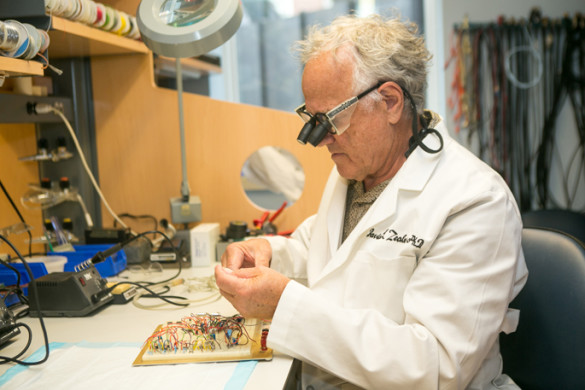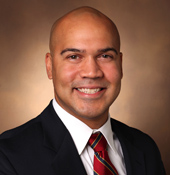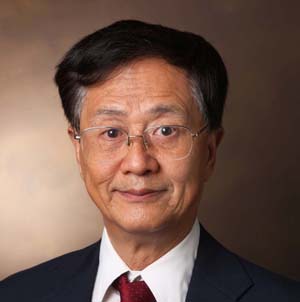
To understand the phenomenal growth of research in the Department of Otolaryngology, step inside the S corridor on the second floor of Medical Center North. That is the location of the department’s gleaming new Laryngeal Biology Laboratory, which occupies the previous footprint of several smaller labs that have now been combined into a shared modern space.
The new lab, which opened a few months ago, is one of three the Department of Otolaryngology has moved into in just the past several months, said Ron Eavey, M.D., Guy M. Maness Professor and chair of Otolaryngology and director of the Vanderbilt Bill Wilkerson Center. The others are housed within the Vanderbilt-Ingram Cancer Center.
More research than ever before is taking place in the department, including funding from the National Institutes of Health (NIH), Patient-Centered Outcomes Research Institute (PCORI) and the Agency for Healthcare Research and Quality (AHRQ). The department ranks fourth among Otolaryngology programs in the nation in NIH funding. Research is underway in specialties throughout the department — in laryngology, otology, pediatric ENT, head and neck cancer, rhinology and in clinical trials.
Last year, the department had 160 publications and 228 scientific presentations. “That’s pretty remarkable for a department of our size,” Eavey said.
The lab in Medical Center North has come a long way since its inception in 1986. That was the year David Zealear, Ph.D., professor of Otolaryngology, came to Vanderbilt and the previous incarnation of the lab opened.
As the department grew, each principal investigator would occupy individual lab space, which resulted in cramped quarters, duplicate equipment and an environment that didn’t encourage collaboration.
The renovation literally removed the walls between investigators. The new space has a dedicated tissue culture room, an equipment hallway and a microscope room.
In the large lab, there are bays for at least a dozen people to work simultaneously, and equipment can be shared. The work also included a new conference room and offices.
The new space is “much more inclusive and provides a top-notch molecular biology resource for us, which we didn’t really have before,” said Zealear, a neurophysiologist with expertise in electrophysiology and functional electrical stimulation as well as director of the Neurolaryngology Research Laboratory at the Vanderbilt Bill Wilkerson Center.
Zealear now shares space with Bernard Rousseau, Ph.D., MMHC, associate professor of Otolaryngology, Hearing and Speech Sciences and Mechanical Engineering; and Justin Turner, M.D., Ph.D., associate professor of Otolaryngology.
“When you have open space that allows collaboration, it allows people to bump into each other, it allows rubbing elbows, exchange of ideas,” said Rousseau, who is also associate vice chair for research in the Department of Otolaryngology, Chancellor Faculty Fellow and director of the Laryngeal Biology Laboratory at the Vanderbilt Bill Wilkerson Center.

The new space is buzzing with research. Zealear is responsible for pioneering studies into the treatment of bilateral laryngeal paralysis — or paralysis of both sides of the vocal folds. Traditionally, this condition would be treated with a tracheostomy or a cordotomy, a laser resection of the vocal cords. These treatments leave many patients with suboptimal outcomes because they are cosmetically unappealing or compromise voice, respectively.
Further, although 70 percent of these patients regenerate their nerves from the site of injury to target laryngeal muscles, the regeneration is random and becomes criss-crossed between antagonistic muscles. Thus, the paralysis remains and must be treated.
Zealear introduced the concept of electrical stimulation to neuromodulate reinnervation of paralyzed laryngeal muscles. He is submitting an NIH grant that would study giving patients an electrical impulse that would regenerate the proper nerve-muscle connections to restore normal motion to the larynx. His research in animals demonstrates that this could happen in paralysis patients.
“This is a cure, not a treatment,” he said. “We’re actually putting the brain connections back to target muscles.”
His treatment, if effective, may be able to translate to restore movement to other paralyzed areas — such as the face, the spinal cord and even the brain.
Rousseau has one R01 project underway at the lab and another on the horizon. The first is a recently-funded $2.7 million study on the pre-clinical testing of the safety and efficacy of treatments for voice disorders.
He is studying patients who develop vocal cord trauma by extensive use of their voices, attempting to develop ways to prevent the trauma or minimize its impact by developing drugs, using existing drugs, or developing new surgical approaches to augment and improve healing of the vocal folds.
On the horizon is a $3 million study, a new submission, to develop a patient-specific surgical planning tool for type 1 Laryngoplasty. This study would address patients with laryngeal paralysis who need a surgical implant. However, patient outcomes are inconsistent because each patient’s anatomy is different and surgeons use different techniques.
Rousseau plans to team with Haoxiang Luo, Ph.D., in the Department of Mechanical Engineering at Vanderbilt University, to develop a computational tool to predict the ideal size, shape and placement of the implant, which would reduce surgical time, controlling costs and improving patient outcomes.
The collaboration is part of an ongoing initiative made possible through the Vanderbilt Institute in Surgery and Engineering (VISE).
“That’s the beauty of these collaborations with Engineering,” Rousseau said. “We partner with engineers to come up with solutions, and engineers rely on us to provide them with challenging problems to solve.”
While Zealear and Rousseau are focusing on laryngeal research, Turner is studying inflammatory nasal and sinus disease, including chronic rhinosinusitis. His NIH-funded study is looking at the mechanism of olfactory loss — loss of the sense of smell — in chronic sinus disease. By understanding the mechanism through which patients lose their sense of smell, he hopes to be able to focus on more selective medical treatments rather than surgery for all patients, which is ineffective in some cases.
Turner is also part of an industry-supported trial looking at the efficacy of surfactant-based nasal irrigations and whether they improve sense of smell.
He welcomes the opportunity to work in the new lab with investigators in different sub-disciplines of Otolaryngology.
“One of the strengths of this collective is that we do different things and we use different approaches and different techniques, different experimental protocols, so I think that this is really going to allow us to learn from each other to broaden our expertise in a lot of these experimental protocols that we’re using,” he said.














